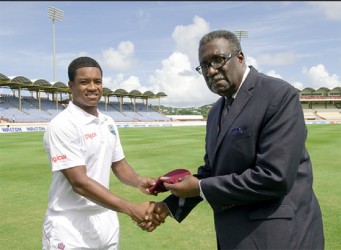By Cosmo Hamilton
When that fateful day September 13, 2014 came as West Indies 500th Test match was recorded, one got the distinct impression that the gifted left-hander Leon Johnson was ready to take his place in the annals of Test history as a batsman, regardless of whomever the opposition might have been – whether it were Australia, India, England or Bangladesh, even in the unaccustomed role of opening batsman. As a 27-year-old debutant and the 300th player to have been officially presented with the coveted burgundy cap, he would have paid his dues, and indeed manifested a sense of maturity as he stepped on to centre stage at the Beausejour ground in St. Lucia to fulfill the promise he showed over a decade ago at the tender age of 16 when he represented Guyana for the first time.
Johnson appeared calm, composed, and confident against the Bangladeshi attack and patiently played out 17 deliveries before he scored his first Test run. Evidently he is blessed with a high cricket intelligence quotient combined with a considerable skill set that made him a fixture in all forms of the game in Guyana and set him squarely in the spotlight in the broader Caribbean as a West Indies prospect at the High Performance Center and in the West Indies A team. Opening the West Indies innings with 21-year-old Kraigg Brathwaite – himself mature beyond his years, in the second Test against Bangladesh, Johnson and his boyish looks made the two seem like old heads on young shoulders as they competently and with apparent ease put on 143 runs for the first wicket.

And when his maiden Test innings came to an end with a dubious LBW decision, Johnson had played a fine knock of 66 which would have arguably placed him in the conversation with his illustrious left-handed compatriots Clive Lloyd who on Test debut scored an impressive 82 with 13 fours and one six against a formidable Indian attack in the First Test at Mumbai in December 1966, as well as opening batsman Roy Fredericks who top scored with 76 on his debut in the Second Test against Australia on Boxing Day in 1968 at the Melbourne Cricket Ground (MCG), facing the likes of pacer Graham McKenzie who on that occasion took 8 for 71. The late lamented lefthander would later confide in me that his focus and concentration were so intense on that day that he suffered a severe headache at the close of play and asked to be sent back to the hotel by taxi.
Local cricket fans would certainly recall the accomplished innings of 100 not out by the stylish 23 year old Berbician lefthander Alvin Kallicharran on his Test debut against New Zealand at Bourda in the 4th Test match of that series in 1972. Then in March of 1994, a precocious 19-year-old southpaw named Shivnarine Chanderpaul announced his arrival in Test cricket with a solid knock of 62 against England at the same storied sward located on the street in Georgetown that now bears his name.
As a keen student of the game, Johnson would be cognizant of the imposing accomplishments of those legendary forerunners and his teammate and countryman and club-mate Chanderpaul, who with every succeeding Test innings scales new heights in his remarkable career. It is too early to tell whether Johnson is the heir apparent to the imposing West Indies opening batsman Jamaican Chris Gayle whom he replaced in the Test series against Bangladesh, and who once intimated that he would opt out of Test cricket if he had his way – a position he later retracted.
However, the Guyanese lefthander would be well advised to be prepared to assume the role of one size fits all utility player of opener or middle batsman whenever called upon. In either instance Johnson would recognize at that level against such high calibre opposition, the necessity to apply the same laser-like focus and concentration applied by the late great Roy Fredericks in that aforementioned innings against Australia but with the propensity to consistently convert half-centuries into big innings.
From the early showing Johnson appears to possess that rare combination of sound technique and mature temperament that are such key elements in the art of batsmanship. It is those qualities bolstered by mental toughness and his cerebral application to the task that would serve him well on this challenging upcoming tour of India as he responds to the probing questions asked of him by the likes of pacers Bhuveneshwar Kumar and Ishant Sharma, and wily spinners Ravichandra Ashwin, Jadeja, and company on difficult Indian pitches before rabidly partisan crowds.




